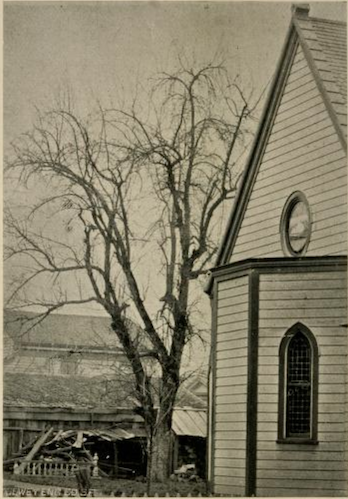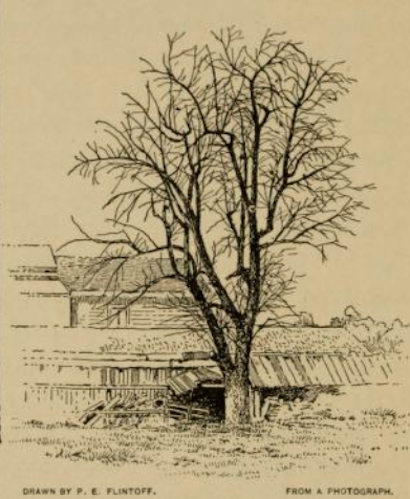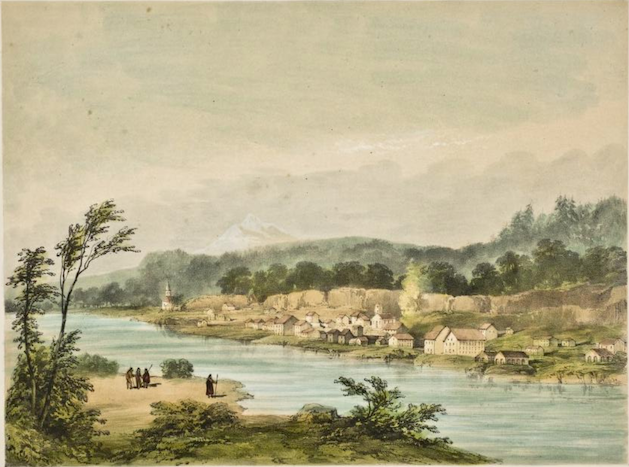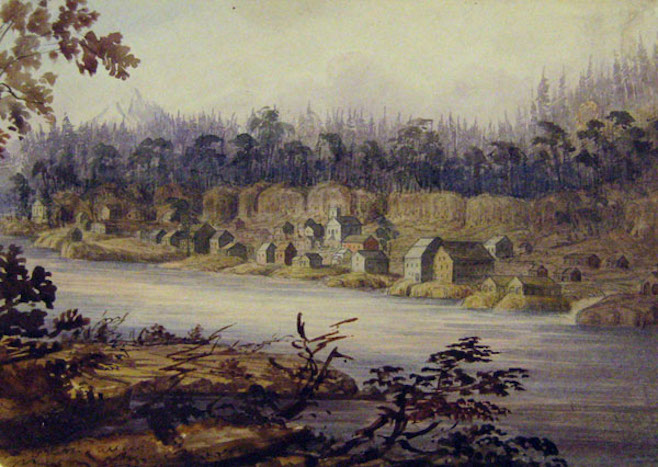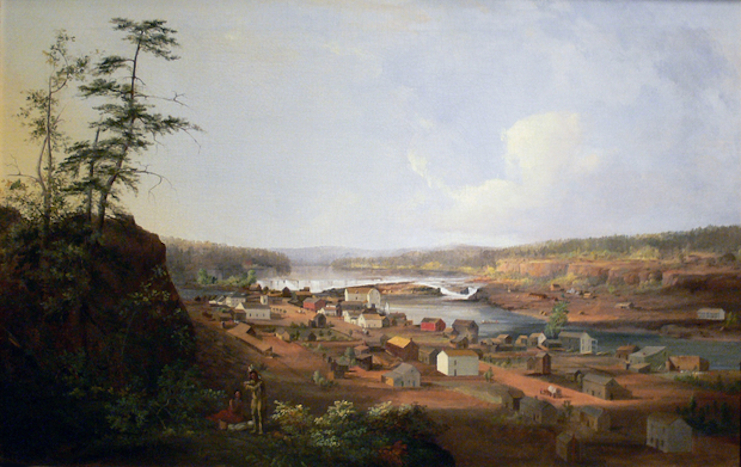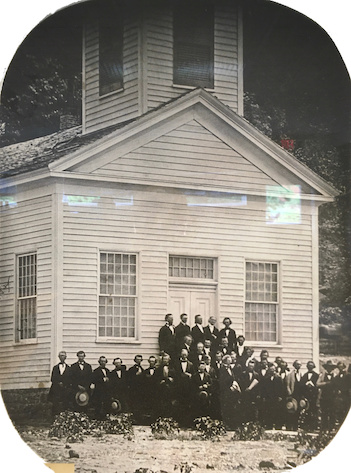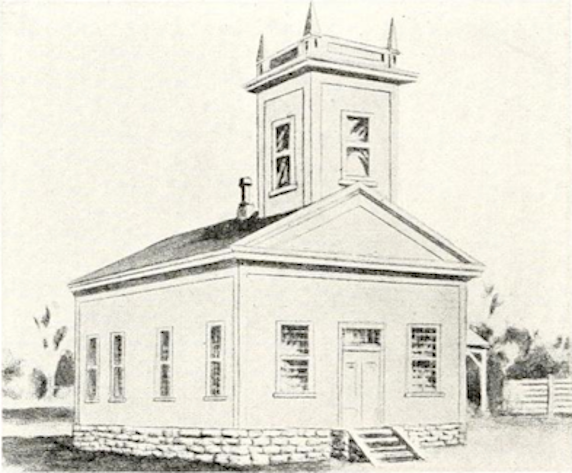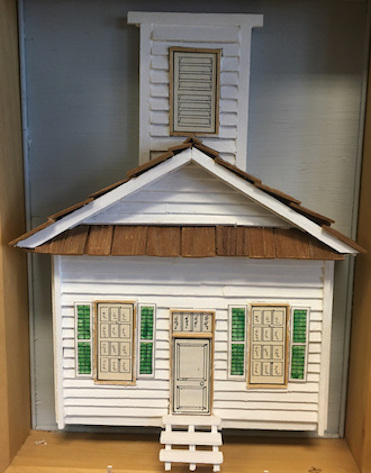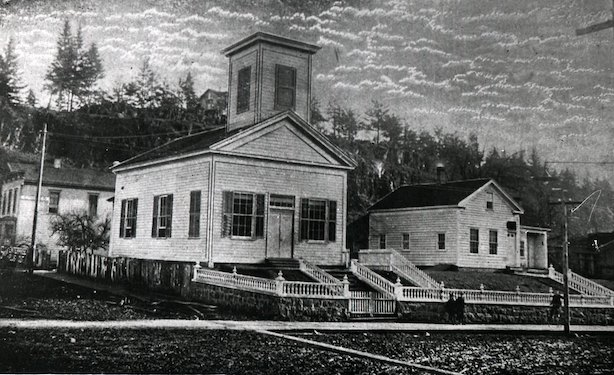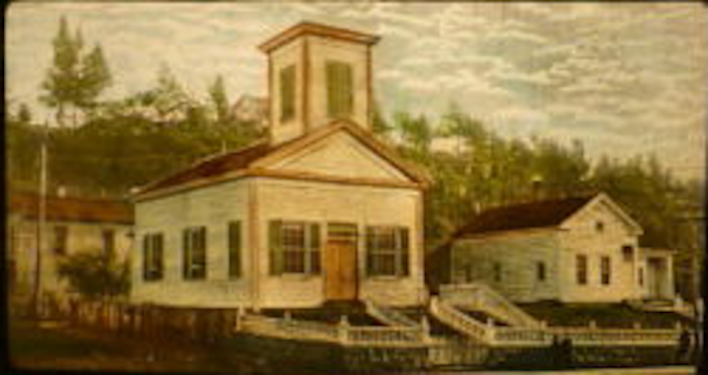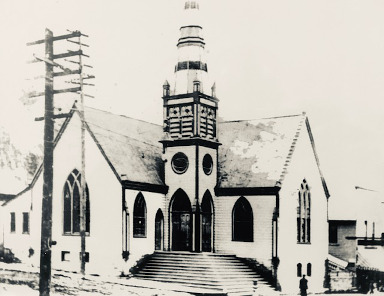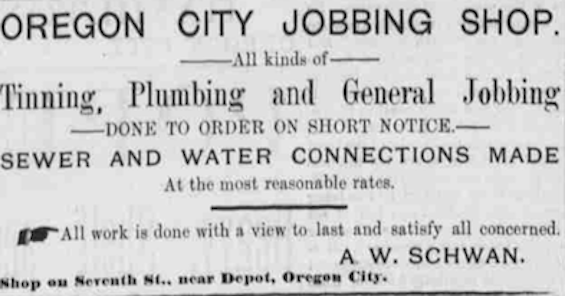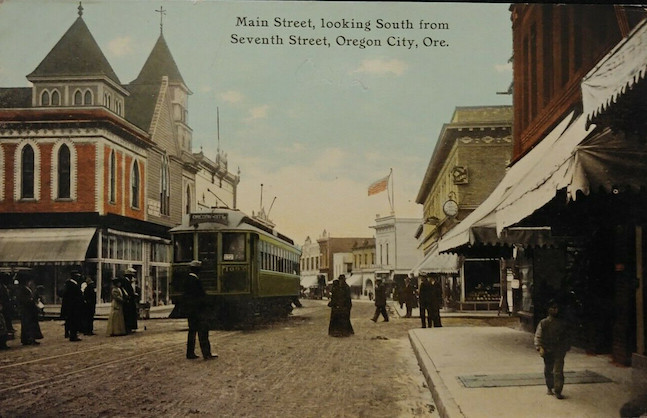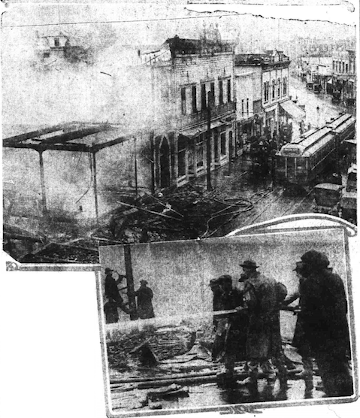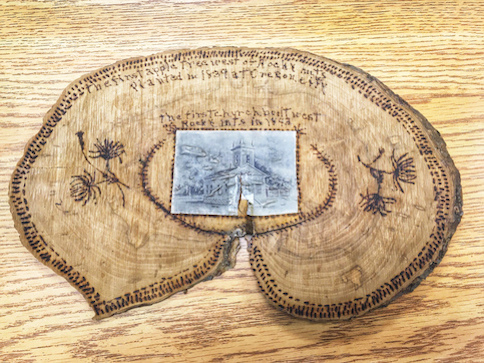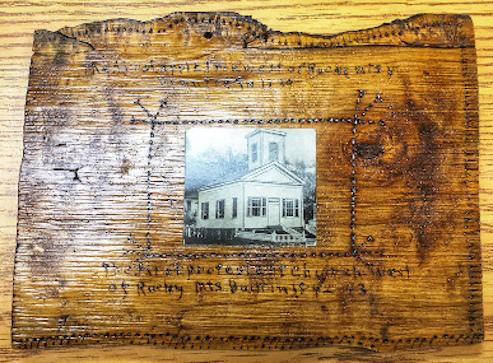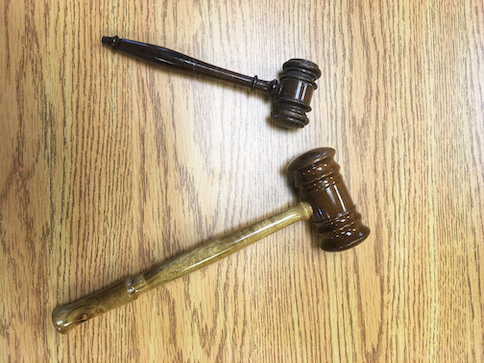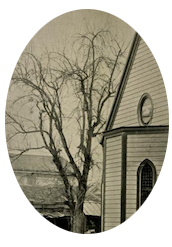
No Ordinary Tree
The first time I laid my eyes on that pamphlet, turned slightly yellow from its age, I was intrigued by the image of a leafless apple tree. It was no ordinary tree, but the first apple tree ever grown on the Pacific Coast and it was right here in Oregon City; not far from where I stood. The tree stood on the yard of the first ever protestant church built in North America, west of the Rockies. That’s a couple of firsts.
Around 1892, the tree made its first appearance in Pacific Christian Advocate, a Methodist newspaper. I have seen a photocopy of this issue, but not able to locate a copy in its entirety. It’s only available in microfiche. The tree again showed up in Hines’ (1896) book on Jason Lee, with the original photo and description from the Advocate. There’s even a passing reference of the tree with an illustration in Fletcher’s (1902) book on the history of Methodism.
This tree started its life in late 1840 as a sapling from seeds thrown away by Rev. Alvin (Alvan) F. Waller’s wife. The seeds from dried apples were brought from New York during Waller family’s long trip to Oregon Territory (Hines, 1896). It’s unusual to grow apple trees from seeds as they are genetically unpredictable but in this case it turned out to be a great fruit bearing tree. Rev. Waller, a Methodist minister, left a mark in early Oregon history due to his dispute with Dr. John McLoughlin over land claims at the Willamette Falls, the present day Oregon City. His main legacy, however, was the establishment of Willamette Falls Methodist Mission and the Willamette University. The Waller Hall at the Willamette University is named after him.
In December 1842, Rev. Waller was the main force behind the subscription drive to fund the construction of the first protestant church, west of the Rockies (Lockley, 1928). In between his busy schedule, he found time to nurse an apple sapling. Rev. Waller’s time in Oregon City came to an abrupt end in 1843, and he was reassigned to the Willamette Mission near Salem. This sudden change probably had to do with the Methodist church’s interest in de-escalating the “situation” with Dr. McLoughlin and the Hudson Bay Company.
Before Rev. Waller left for Willamette Mission, he handed the sapling to Rev. Gustavus Hines, a fellow missionary at “The Falls” (Hines, 1896). Rev. Hines planted the young tree near the parsonage, where he was residing. The building of the Methodist Episcopal (M. E.) Church which started during Rev. Waller’s time was completed in 1843 at the corner of Third and Main Street. The dedicatory sermon was given by Rev. Hines (Lockley, 1928).
Getting back to the apple tree, it didn’t appear in any of the church drawings or photograph(s) at its first location. This is where it gets interesting. The Oregon City Enterprise (Nov 18, 1904) mentioned the tree was planted - “in front and near the corner of the parsonage, that was situated just south of the present day Methodist church, on Main street in Oregon City.” The newspaper was referring to the second location of the church at the corner of Seventh and Main Street. However, the church and the parsonage wasn’t moved from its original location at Third and Main Street until the winter of 1855. I believe the tree was initially planted in the Third Street location and later replanted in Seventh Street.
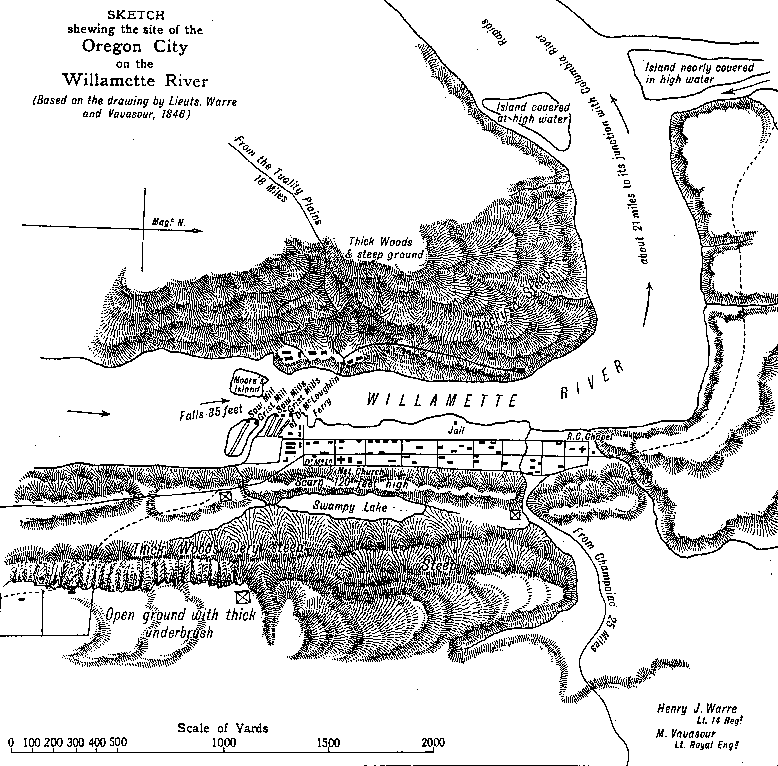
Oregon City Map, 1846 by Henry J. Warre. Note the location of the church marked by a cross, just above the Swampy Lake (Rich, 1944)
An illustration of the M. E. Church first shows up in the painting of Henry J. Warre, a British army officer. Warre visited Oregon City around January 1845. He even had the good fortune of dining at the house of Dr. McLoughlin’s son. (Major-Frégeau, 1976). During his visit, he drew a detailed hand-drawn map of Oregon City where he showed the location of the church (Rich, 1944).
Though lithographs (Warre, 1848) of Warre’s paintings are common, I am including both his painting and lithograph to illustrate the difference between the artist’s original intention and a lithographer’s interpretation. The M. E. Church is in the middle of the picture. The St. John the Apostle Church appears on the extreme left. The church was again captured in John Mix Stanley’s painting from 1850. Stanley’s painting portrays the church from the bluff on the Oregon City side.
The M. E. Church on Third Street holds a special place in Oregon history. Oregon’s provisional legislature met here in 1847. The first meeting of the Oregon’s Territorial Legislature took place here on July 16, 1849. This was the meeting where the legislative body decided to change “the names of Champoeg, Tualatin, and Vancouver counties respectively to Marion Washington and Clark” (Gaston, 1912). George Abernethy, the first Governor Oregon under the provisional government, even donated the church bell.
In 1855, the third annual Oregon Methodist conference was held in Oregon City. It attracted all types of missionaries and church clergy men from the Oregon territory. The only known photograph of the M. E. Church at the Third Street location was taken during this occasion. If you look at the picture carefully, the church building doesn’t look that small anymore.
A sketch of the church appeared in a couple of Gaston’s books on Oregon (Gaston, 1911 and 1912). It’s the clearest illustration of the M. E. Church at its first location that I’ve come across. A model of the old church building is displayed at the Oregon City Methodist United Church, the present day M. E. Church. Notice the wood shingles and the green shutters. The old church building would make a very nice Lego model. Maybe I’ll try it one day.
In 1855, the church was moved to its second location at the corner of Seventh and Main Street. According to Lynch (1973), “it seemed profitable to move to the corner of Seventh and Main Street on the block which the church won in settlement with Dr. McLoughlin, and to sell the other location. E. W. Swafford took his ox-team and moved the church and parsonage down the street”. Elias W. Swafford was an early pioneer at Oregon City and at one time held the office of Steward in the M. E. Church (Hines, 1893).
The apple tree made an appearance in most of the church pictures at the second location. A few different black and white pictures of the church, at its second location, is floating around the internet. The most frequently cited picture comes from the collection of Oregon State University. The only colorized photo of the M. E.Church that I have across was in a slide series titled “The Indian Trail” put out by M. E. Church.
By 1890, the church became too small for its growing congregation and was replaced by “a handsome modern structure with gothic windows and a tall spire was erected on the front” (Lynch, 1973). The architecture of this particular building reminds me of the churches designed by Architect Benjamin D. Price. Price’s plans were sold by the Methodist Episcopal Church Board to its congregations to discourage them from building churches of their own design.
The original church building was moved to the back of the property, facing Seventh Street and close to the train depot. As per Muno (1975), “the original church building on the back of the lot was leased to A.W. Schwan in 1891 and permission was given to repair and remodel the structure for business purposes by removing the belfry, erecting a square front and making the room suitable for display of goods”. Schwan set up a tinning and plumbing shop in the old building and frequently advertised in local newspapers.
The old building even showed up in the Sanborn fire insurance map from 1892. However, the old parsonage was missing from the map. No one is sure as to what happened to the old parsonage. The apple tree was still around in 1896 (Hines, 1896) and was probably cut down in 1900 when new buildings were built beside the church. The Oregon City Enterprise (June 20, 1902) made a reference to the tree while reporting on pioneers reunion - “In a lot adjoining the Methodist church in Oregon City there stood until a few years ago, when it was cut down and sold for souvenirs, an old apple tree, the first tree of its kind in Oregon, now so famous for its apples.”
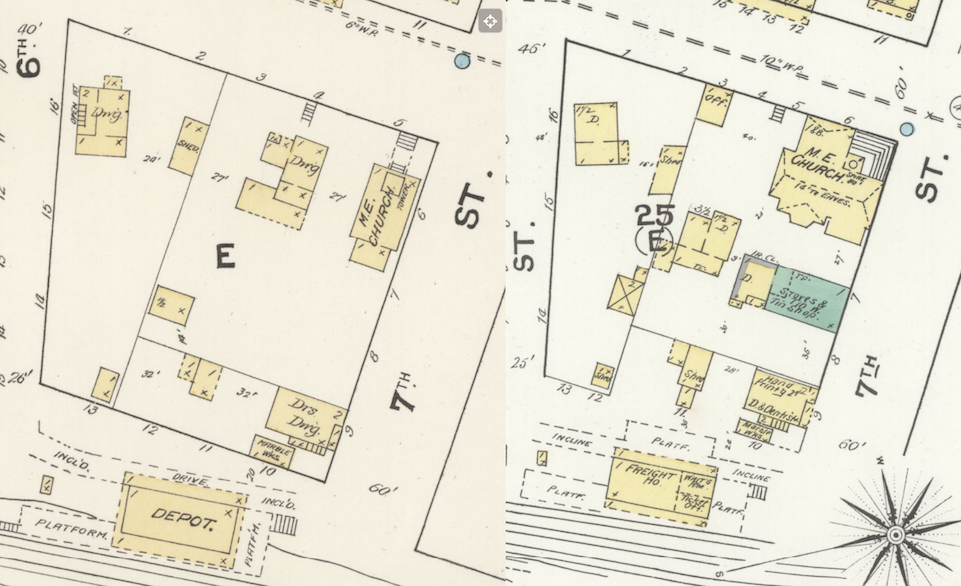
Note the locations of the old church building in 1888 and 1892 (right) Sanborn Fire Insurance Maps
The old church building showed up again in the fire insurance map from 1900 but was no longer present in the 1911 map. The building was probably relocated somewhere between 1903 and 1909 when the M. E. Church went through a few major renovations including hoisting the church to make it a second story, and adding the L. Adams Department store at the street level (Oregon City Enterprise, June 26, 1903).
The last time there was any reference to the old church building was when the 1909 Methodist Conference, held at Cottage Grove, discussed moving the old historical church building to the campus of Willamette University (Oregon City Enterprise, September 24, 1909). Unfortunately, the present day Oregon City United Methodist Church has no record of when the original building was torn down. Most of the church documents were destroyed in the big fire of November 15, 1919. The fire completely burnt down the church including the Price Bros. department store on the first floor (The Sunday Oregonian, November 16, 1919). I heard the corner post of the old church building was saved as a memorial and currently displayed at the Museum of the Oregon Territory, Oregon City.
The apple tree was cut down and sold as keepsakes. Some wooden pieces were turned into plaques and others into gavels. A few of the historic artifacts are in display at the Methodist United Church. Two of the gavels, displayed at the church, were used at the Willamette Mission School near Salem. One such gavel was presented to Abernethy Grange (Oregon City) by Captain John T. Apperson of Unio fame. It was fashioned from the apple tree and the handle carved from another historic tree, this time a cherry, planted by Seth Luelling (Oregon City Enterprise, November 18, 1904). Luelling, a horticulturist, known for creating the Bing cherry. This particular gavel had an engraved silver band around it. I was given the impression that the gavel is still in use by the grange. As to what happened to the old church building, and the parsonage is still a mystery.
References
-
Warre, Henry J., Sketches in North America and the Oregon Territory, Dickinson & Co., 1848
-
Sanborn Fire Insurance Map from Oregon City, Clackamas County, Oregon, Sanborn Map Company, October 1888
-
History of the Pacific Northwest: Oregon and Washington, Vol II, The North Pacific History Company of Portland, Oregon, 1889
-
Sanborn Fire Insurance Map from Oregon City, Clackamas County, Oregon, Sanborn Map Company, April 1892
-
Hines, Harvey Kimball Hines, An Illustrated History of the State of Oregon, Part 1, Lewis Publishing Company, 1893
-
Oregon City Jobbing Shop Advertisement, Oregon City Enterprise, July 07, 1893
-
Hines, Harvey Kimball, Jason Lee, The Pioneer of Methodism and Civilization on the Pacific Coast, J.D. Hammond, 1896
-
News about A. W. Schwan selling his store, Oregon City Courier, April 30, 1897
-
Sanborn Fire Insurance Map from Oregon City, Clackamas County, Oregon, Sanborn Map Company, May 1900
-
Reunion of Pioneers, Oregon City Enterprise, June 20, 1902
-
Hurst, John Fletcher, The History of Methodism, Volume 2, Eaton & Mains, 1902
-
To Re-dedicate Church, Oregon City Enterprise, May 29, 1903
-
Rededication of Church, Clackamas County Record, June 22, 1903
-
Occupy New Home, Oregon City Enterprise, June 26, 1903
-
Gavel of Historic Wood, Oregon City Enterprise, November 18, 1904
-
Partial Report of Committee on Digest, Journal of Proceedings of the National Grange of the Patrons of Husbandry, Volume 38, Portland, Oregon, 1904, National Grange, 1904
-
What to See and How to See It and Book and Guide, Portland Chamber of Commerce, Oregon, 1905
-
E. W. Swafford is Dead, Oregon City Enterprise, October 9, 1908
-
Remove Old Church from Oregon City, Oregon City Enterprise, September 24, 1909
-
Carleton, Hubert; Randall, George Herbert; Palmer, Leon C. Palmer, St. Andrew’s Cross, Volume 25, Brotherhood of St. Andrew in USA, 1910
-
Sanborn Fire Insurance Map from Oregon City, Clackamas County, Oregon, Sanborn Map Company, November 1911
-
Gaston, Joseph, Portland, Oregon, Its History and Builders, Volume 1, The S.J. Clark Publishing Co., 1911
-
First Methodist Church to Have Re-opening Today, Morning Enterprise, Oregon City, April 14, 1912
-
Gaston, Joseph, The Centennial History of Oregon, 1811-1912, Volume 1, S.J. Clarke Publishing Company, 1912
-
Proposed New Building of Price Brothers which will be Completed by April First, Oregon City Courier, October 18, 1917
-
Oregon City Scene of $200,000 Blaze, The Sunday Oregonian, November 16, 1919
-
Oregon City Suffers $225,000 Fire Loss, The Oregon Daily Journal, November 15, 1919
-
Substantial Fund Raised For Firemen, Oregon City Enterprise, December 12, 1919
-
Lockley, Fred, History of the Columbia River: From The Dalles to the Sea Volume 1, The S. J. Clarke Publishing Company, Chicago, 1928
-
Oregon Writers’ Project, An Oregon Almanac for 1940 - A Handbook of Fact and Fancy, Work Projects Administration, State of Oregon, 1940
-
Rich, E. E., ed., The Letters of John McLoughlin from Fort Vancouver to the Governor and Committee, Third Series, 1844-46 , volume III, The Champlain Society, 1944
-
Lynch, Vera Martin, Free Land for Free Men; a Story of Clackamas County, Artline Print, 1973
-
Muno, D. Paul, Bennet, Helen, History 1840-1975 First Methodist Church of Oregon City, Oregon, 1975
-
Major-Frégeau, Madeleine, e.d., Overland to Oregon in 1845: Impressions of a Journey Across North America by H. J. Warre, Public Archives of Canada, Ottawa, 1976
-
Friedman, Ralph, In Search of Western Oregon, Caxton Press, 1990
-
Fuller, Tom, Oregon’s Capitol Buildings, Arcadia Publishing, 2013
